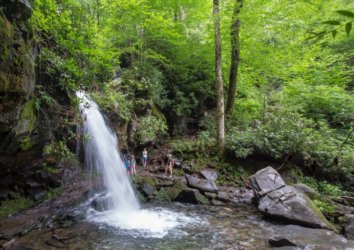Vacations are a time for indulgence, but that doesn’t mean that you need to be unhealthy or unsafe when traveling. The Great Smoky Mountains National Park provides the ultimate opportunity to keep active and maintain your diet without sacrificing fun. This destination also makes it possible to enjoy a safe getaway even as COVID restricts many of the travel plans we previously took for granted.
While staying healthy is more than possible as you explore the Smoky Mountains, it’s not guaranteed. The same destinations that lend themselves to nutritious meals, intense exercise, and social distancing can also encourage you to eat greasy foods, lounge in comfy accommodations, or risk spreading or transmitting the virus. A little planning can make a world of difference, however.
Keep these considerations in mind as you prepare for a health-conscious trip to the Smoky Mountains:
Opportunities for Social Distancing
While outdoor environments such as national parks are preferable for reducing the spread of COVID, a lot depends on where and when you visit. After all, several top destinations within Great Smoky Mountains National Park are known for drawing significant crowds — especially when peak autumn colors arrive.
Packed parking lots and tourist attractions can increase the potential for spreading disease. Hence, the value of planning ahead to either visit lesser-known sites or check out top attractions when they’re less busy. Do your research to pinpoint the park’s hidden gems. If you’re dead-set on stopping by the park’s most popular destinations, plan to arrive bright and early, when most vacationers are still sleeping.
Hiking

Remote hiking trails are ideal in that they provide a serene experience while also limiting up-close interactions with other visitors. Consider adding the following to your itinerary:
- Cosby Nature Trail
- Buckeye Trail to Spruce Flats Falls
- Metcalf Bottoms Trail
- The North Carolina side of Mouse Creek Falls
- Welch Ridge Loop
- Mount Cammerer
- Gabes Mountain Loop
When determining whether to tackle remote or lesser-known trails, balance COVID-related risks against your own ability to navigate terrain that may be more challenging, or, depending on the time of year, downright dangerous. Come prepared with proper footwear and other equipment to help you handle difficult trails with ease. Thankfully, the park is home to many trails that are both secluded and easy to navigate.
Scenic Drives

A winding road curves through autumn trees
Certain Smoky Mountain drives are always popular during the fall, when visitors arrive from near and far in hopes of witnessing the spectacular colors. This year, however, this socially distanced activity is in greater demand than ever.
If you don’t like the idea of feeling stuck in traffic in a national park, swap out the area’s best-known routes for less-traveled roads that still provide exceptional scenery:
- Rich Mountain Road
- Foothills Parkway
- Lakeview Drive
As with the park’s most secluded hiking trails, lesser-traveled roads tend to be more dangerous. Steep grades and sharp bends can be hazardous even in ideal weather conditions, but snow and ice make roads even more treacherous. As such, some roads may not be open if you visit in late fall or during the winter.
If possible, plan to take a highly capable SUV or some other vehicle with four-wheel drive. Save your journey for a day in which you’re feeling alert, as even slight drowsiness can prove dangerous.
While scenic drives can be ideal for social distancing, they’re not great for promoting physical activity. When possible, plan both driving and hiking into your day. Many top routes meander past a variety of trails worth checking out. You’ll appreciate the break from sitting — and you just might find that you cherish the scenery, even more, when you witness it on foot.
Eating Healthy
The Appalachian region isn’t exactly known for its healthy cuisine. Nutritious meals and snacks can be found, but they don’t always look enticing compared to the comfort foods found at many of the region’s top restaurants. If you’re determined to stick to your diet, you’ll need to plan ahead to ensure that, as soon as you feel hungry, you’re able to grab a nutritious snack or meal.
First: pack plenty of quality snacks to keep you fueled during long hikes or drives. This will reduce your need to grab treats at the park’s many snack bars, concession stands, or vending machines. Trail mix is always a winner, as are apples, dried fruit, and some granola or energy bars.
Water is even more important. Pack more than you think you need to ensure you remain hydrated throughout the entirety of your hike. Keep a filter on hand just in case your hike lasts longer than anticipated.
If you stay in accommodations outside of the park, set aside some time to learn about the various restaurants situated within walking distance of your vacation digs. When cravings hit, which dining destinations can you reach quickly? Which include reasonably healthy items on the menu? When possible, balance the desire for a vacation treat against your commitment to maintaining your diet. Look for locations that offer small portion sizes or allow you to split large meals.
If you’re worried about social distancing at restaurants, stick with locations that offer delivery or curbside service. Many of these are situated near local parks, where you can enjoy a scenic picnic. Otherwise, your accommodations may include a kitchen, where you can whip up a healthy meal or simply use the table to enjoy takeout.
Whether your health goals for your vacation involve low-calorie meals, hours of hiking, or strict social distancing, they can easily be accomplished as you explore Great Smoky Mountains National Park. This is your opportunity to make wonderful memories without compromising your personal health or safety. Treat yourself to a trip that both challenges and delights you and those you love most.




